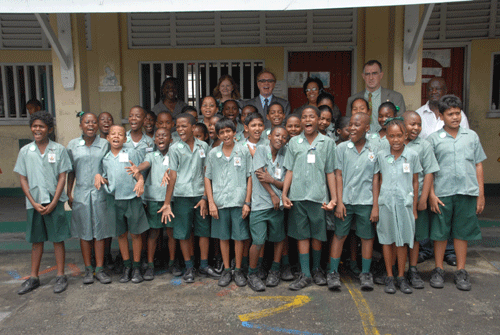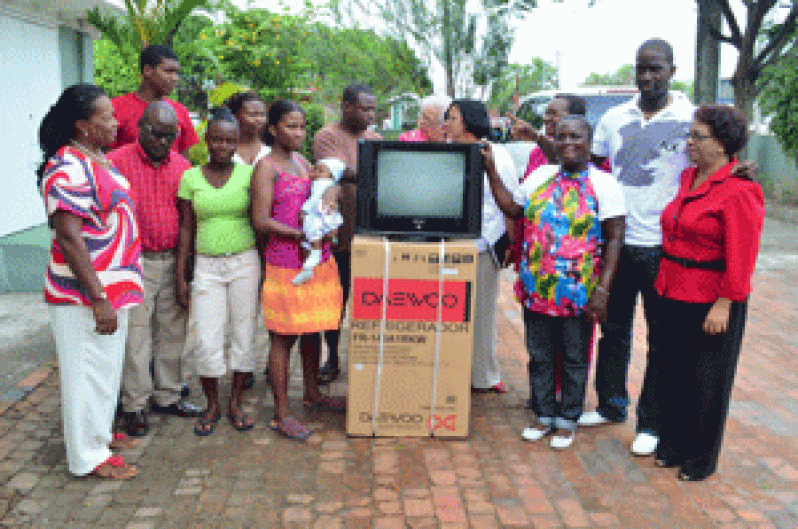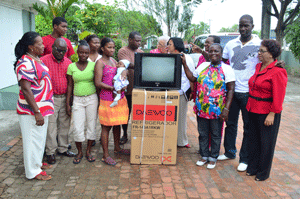TWO-hundred-and-fifty years after he led a revolt of more than 2,500 slaves against the plantation slave system, Cuffy, the subject of the 1763 Monument at the Square of the Revolution in the capital Georgetown, also inspired a round-table conference presented by the School of Education and Humanities, Department of Language and Cultural Studies, and the African Studies Research Group of the Department of Language and Cultural Studies of the University of Guyana.
|
|
 |
| Dr Winston McGowan addressing attendees of a round-table conference held two Thursdays ago at the University of Guyana (Photos by Sonell Nelson) | |
The theme of the event, held in the Education Lecture Theatre on the Turkeyen campus, was ‘In the Shadow of Kofi, also known as Cuffy: Implications for the African Caribbean’.
The lecture was delivered by Professor Emeritus, Dr Winston McGowan, who said that not as much is known about Kofi as it should be. In his address, as noted on the programme, Dr McGowan was slated to speak on ‘Who was Kofi, also known as Cuffy? His antecedents, his education; his deeds, his legacy’.
From what the history books tell us, we know that Cuffy, a national hero in Guyana, was an Akanman who was captured in his native Ghana, and sold into slavery to work in the plantations of the Dutch colony of Berbice in present-day Guyana. He worked on a plantation on the Canje River as a house slave.
The African slave population grew as plantations expanded. The White plantation owners were mainly concerned with exploiting the slaves for labour, and little effort was ever made to improve the wretched and degrading conditions under which they were forced to live.
With the harsh treatment and brutal punishments inflicted on them by their owners, some slaves rebelled, while others, from time to time, escaped into the forests. Those who were recaptured suffered horrible deaths as punishment, meant also as a deterrent to other slaves who might have planned to escape.
Following an unsuccessful rebellion of 36 slaves in 1762, just a few months later, around February 23, 1763, a more organized revolt, which became known as the Berbice Slave Rebellion, took place.
The uprising initially broke out at Magdalenenburg, a plantation owned by a widow, Madam Vernesobre, on the Upper Canje River. The slaves killed the manager and carpenter, burned down the owner’s house, and moved on to neighbouring plantations, and as far as the Corentyne, to urge support from the slaves there, some of whom attacked their owners, and either joined the others or escaped into the forest.
Very quickly, the rebelling Africans were organised as a fighting force by Cuffy, who was a house slave on another Canje plantation, Lilienburg, where the slaves had also rebelled.
Cuffy had been brought to this plantation ever since he was a child, and had been trained as a cooper by the owner, Barkey.
As laid out on the programme, Lecturer, Ms Cecelia McAlmont presented on Haitian National Hero, Toussaint L’Overture, under the heading, ‘Other liberators in the Caribbean: The Profile of Toussaint L’Overture’.
Born François Dominique Toussaint L’Ouverture (1743 -1803) to slave parents near Cap-Français, Saint-Domingue (now Cap-Haïtien, Haiti), Toussaint acted as physician to the insurgent army, and became a leader of the Haitian Slave Revolt, a 1791 black slave uprising against the French colonial regime.
After France abolished slavery in the territory in 1794, Toussaint supported the French rulers of the country against British invaders, and was made a general in 1795. In 1801, he succeeded, after many struggles, in liberating Saint-Domingue from French control, and became President-for-life of a new republic.
In 1802, Napoleon sent troops under the command of his brother-in-law, General Charles Victor Emmanuel LeClerc, to subdue the Haitians. Toussaint was defeated, captured, and accused of conspiracy. He was taken to France, where he was imprisoned and died the next year. He is honoured today as one of the founders and heroes of Haiti.
Lecturer Al Creighton presented on ‘The Maroons of Jamaica, and the Struggle for Liberation’. The Jamaican Maroons are descended from slaves who escaped from slavery and established free communities in the mountainous interior of Jamaica during the long era of slavery in the island.
African slaves imported during the Spanish period may have provided the first runaways, apparently mixing with the native American Taino or Arawak people that remained in the country. Many gained liberty when the English attacked Jamaica and took it in 1655, and subsequently runaways were referred to as “maroons.”
Venezuelan Ambassador to Guyana, H.E. Reina Margarita Arratia Diaz, spoke on ‘The Role of General Simon Bolivar in the Liberation War of the Nineteenth Century’.
Bolivar (1783-1830) was a South American revolutionary, military leader, and politician known as the Liberator for his leading role in the wars of Spanish American Independence. More than anyone else, Bolívar was responsible for the independence of five countries: Venezuela, Colombia, Ecuador, Peru, and Bolivia.
Today, most Spanish Americans hold Bolívar in high regard for his role as a leader of the Independence (see Latin American Independence).
Lecturer Aubrey Norton discussed ‘The process of becoming a National Hero’. It is worth noting that the afternoon’s events were off to an energetic start as the conference was preceded by drumming on the tarmac, compliments of ‘The African Warriors of Buxton’, led by Master Drummer, Mr Herman Blenman.



.jpg)












